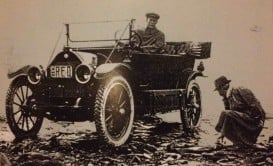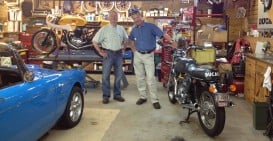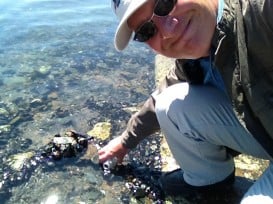Day 16 on the Trans-Canada, Wentworth, Nova Scotia
Trans-Canada distance: n/a
Getting water from Halifax Harbour
Share
Trans-Canada distance: n/a
Actual distance driven: 4,046 km

THEN: The original pair of “Pathfinders,” Thomas Wilby and Jack Haney, who made the first coast-to-coast Canadian road trip 100 years ago, set off from Halifax Harbour in rain and drove north on muddy roads.
It can’t have been much fun in the open car, and especially not since Wilby, the British snob, sat in the back and would not have cared for conversation with Haney, the American mechanic who was provided as the car’s driver and caretaker.
The roads that the two would have followed were narrow and unpaved, and no maps existed to show their route. There seemed little need– fewer than 200 cars were registered in Halifax at the time. Instead, the duo were led north by a guide in one of those cars, and they stopped just five kilometres outside of town for a drink at an inn, where the locals’ curiosity was eventually stirred when the guide told them of the long drive expected to Vancouver.
At that, everyone went outside to look at the car, while Wilby considered them with disdain. “Vancouver awoke only vague geographical associations,” he wrote later. “It had no connection with their lives; it suggested a journey to the moon.”
If there was to be a link between Atlantic and Pacific, most people didn’t see cars as the way of providing it. In his book “The All-Red Route,” author John Nicol quotes an editorial from the Halifax newspaper that year:
“Is it reasonable, that the mass of the people, who will never own an auto, will give up the roads they made and practically own to the devil machines? Is it reasonable to believe that the legislature will take the roads of the country people away and transfer them to the rich men who may wish to make motor tracks of them? …
“In this province, where the country is hilly and the roads narrow, if an automobile comes suddenly over a hill in the face of a horse unacquainted with them, 10 men would not keep him from going over the bank with the wagon to which it may be attached. Automobiles have not come to stay. Just wait until they kill a few people by tumbling the wagon in which people are travelling peacefully along. They haven’t come to stay on country roads, and they won’t stay.”

NOW: I drove to Eastern Passage to dip the wheels of the Camaro into the Atlantic. I did this already in Newfoundland, as you can see on this CBC clip, but it just seemed right to do it again, as a tip of the ball cap to Wilby and Haney. You can see today’s video here.
From there, I drove slowly along the old Waverley Road, which was the original road north from Halifax Bay, and dropped in to visit with Dave Munroe, to talk cars and motorcycles for a while. Munroe is a retired motorcycle dealer and former national chair of the Canadian Automobile Association.

It was a relaxed afternoon but perhaps too relaxed – I’d intended to follow the Waverley Road all the way through the countryside to Truro, but realized when I left Munroe’s house that time was getting on; if I followed the old route I may not get to my destination here in the Wentworth Valley before dark.
So just a few kilometres north, I swung onto the main throughway and set the cruise control to 120 km/h. Every now and again, to my right, I could see the old road through the trees.
SOMETHING DIFFERENT … Here I am, topping up my bottle with water from the Atlantic at Eastern Passage, across the bay from Halifax, Nova Scotia.

I’m topping it up because I already had Atlantic water in there from Petty Harbour, Newfoundland, which I’d gathered on the first day of this drive, two weeks ago. You can see the considerably-less-than-graceful video of the historic event here. But I didn’t have as much as I’d started out with.
After putting that quarter-bottle in the car and setting off across Newfoundland, I just left it rolling around behind the seat and forgot about it. I bought other bottles of drinking water since then. And a few days later, I was fumbling around for a bottle of water while driving and, yes, pulled up the ocean water bottle and gave it a healthy swig. Except, of course, it was a very unhealthy swig, full of salt and fish pee. I spewed my mouthful through the open window, although most of it was picked up by the slipstream and hurled back inside the car.
Anyway, today I needed to top up the bottle so that I can pour it into the Pacific. All very symbolic, though it would be more symbolic, of something, if I just spit it into the ocean at Vancouver.
The bottle of salt water is now carried safely in the trunk, and it won’t be leaving the trunk until I get to the left coast.